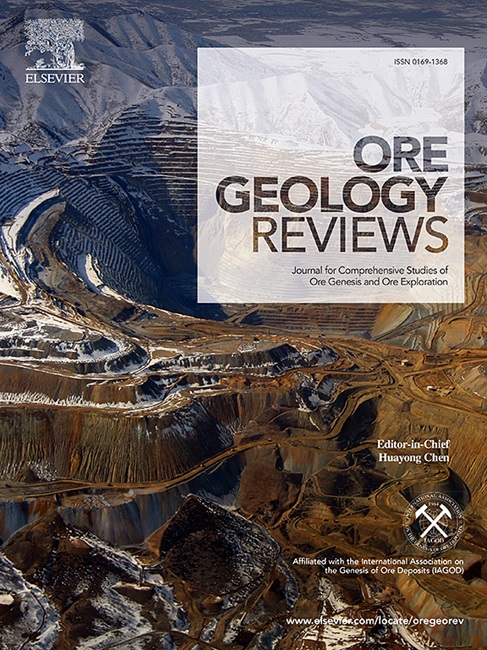The age of the Yuanjiacun banded iron formation in the North China Craton revisited
IF 3.6
2区 地球科学
Q1 GEOLOGY
引用次数: 0
Abstract
Banded iron formations (BIFs) represent an iron-rich rock type that typifies Archean and Paleoproterzoic supracrustal successions, with nearly the absence of BIFs deposited during the Great Oxidation Event (GOE; 2.4–2.2 Ga). This paucity renders us difficult to apply BIFs to understand a shift of paleoenvironmental conditions in time and space and its specific control mechanism on BIF deposition. In this regard, we focus on the Yuanjiacun BIF in the Lüliang area of the North China Craton (NCC), because it is a potential BIF that might be deposited during the GOE. If the formation age of this BIF is confirmed, it would hold great potential as a good archive to record the redox conditions and transitions in the atmosphere–ocean system and reveal its genetic relationship to the paleoenvironmental evolution. Here, we present a detailed compilation of all previously published zircon U-Pb ages of metamorphosed sedimentary rocks within the Lüliang Group to assess the formation age of the Yuanjiacun BIF. In combination with our newly obtained SHRIMP zircon U-Pb ages of sericite-quartz phyllites intercalated with this BIF, we can further clearly recognize the major detrital zircon age distribution of the Lüliang Group to get a good understanding of its provenance. Results show that the youngest detrital zircon population of associated metamorphosed sedimentary rocks occurs between 2.23 and 2.20 Ga, representing the maximum depositional age of these rocks. This age, coupled with the formation ages of overlying volcanic rocks, further provides a well constraint on the depositional age of the Yuanjiacun BIF to ∼2.23–2.21 Ga, clearly during the GOE. In addition, the detrital zircon age distribution yields a dominant 2.5–2.6 Ga age population and subordinate age peaks at ∼2.2 Ga, 2.3–2.5 Ga, 2.6–2.8 Ga, and ∼3.0 Ga, suggesting that detrital zircons were sourced predominantly from weathering of Archean igneous rocks, possibly located in both Lüliang and adjacent Fuping-Wutai-Hengshan regions. By further constructing a comparision with other Paleoproterozoic strata in the NCC, we highlight the significance and uniqueness of the Yuanjiacun BIF. Its deposition is slightly older than nearly all Paleoproterozoic successions distributed in other regions of the NCC.

重新考察了华北克拉通袁家村条带状铁组的时代
带状铁地层(BIFs)代表了太古宙和古元古代表壳序列的富铁岩石类型,在大氧化事件(GOE)期间几乎没有banif沉积;2.4 - -2.2 Ga)。由于生物多样性的缺乏,我们很难利用生物多样性特征来理解古环境条件的时空变化及其对生物多样性特征沉积的具体控制机制。因此,我们将重点研究华北克拉通l梁地区的袁家村BIF,因为它是一个可能在GOE时期沉积的潜在BIF。如果确定其形成年代,它将成为记录大气-海洋系统氧化还原条件和转变,揭示其与古环境演化的成因关系的良好档案。在此,我们详细汇编了前人发表的所有梁群变质沉积岩的锆石U-Pb年龄,以评估袁家村BIF的形成年龄。结合新获得的绢云母-石英百元岩SHRIMP锆石U-Pb年龄,可以进一步清晰地识别出l梁群主要碎屑锆石年龄分布,从而更好地了解其物源。结果表明,伴生变质沉积岩最年轻的碎屑锆石群出现在2.23 ~ 2.20 Ga之间,代表了这些岩石的最大沉积时代。这一年龄,加上上覆火山岩的形成年龄,进一步提供了袁家村BIF沉积年龄在~ 2.23-2.21 Ga的良好约束,明显是在GOE时期。此外,碎屑锆石年龄分布以2.5 ~ 2.6 Ga为主,次峰为~ 2.2 Ga、2.3 ~ 2.5 Ga、2.6 ~ 2.8 Ga和~ 3.0 Ga,表明碎屑锆石主要来源于太古代火成岩的风化作用,可能位于柳梁地区和相邻的扶平-五台-横山地区。通过与华北地区其他古元古代地层的对比,凸显了袁家村生物多样性特征的重要性和独特性。它的沉积时间比华北地区其他地区几乎所有的古元古代序列都要早。
本文章由计算机程序翻译,如有差异,请以英文原文为准。
求助全文
约1分钟内获得全文
求助全文
来源期刊

Ore Geology Reviews
地学-地质学
CiteScore
6.50
自引率
27.30%
发文量
546
审稿时长
22.9 weeks
期刊介绍:
Ore Geology Reviews aims to familiarize all earth scientists with recent advances in a number of interconnected disciplines related to the study of, and search for, ore deposits. The reviews range from brief to longer contributions, but the journal preferentially publishes manuscripts that fill the niche between the commonly shorter journal articles and the comprehensive book coverages, and thus has a special appeal to many authors and readers.
 求助内容:
求助内容: 应助结果提醒方式:
应助结果提醒方式:


